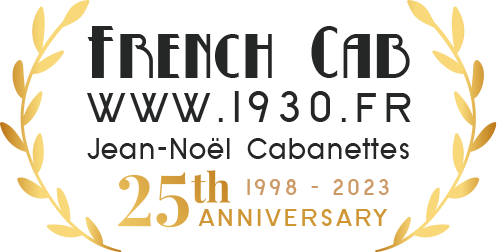Art deco Sculptures. Bronze or Spelter ?
Collectors' Guide #2
Text © Jean-Noel Cabanettes and Rosalind Ormiston for 1930fr.

What to Look for
Buyers of Art Deco sculptures are often confused about the significance of different metal materials – bronze, spelter, metal alloys – used in their creation. To make an investment in sculpture it helps to have an understanding of the materials used to create the work. In Classical times bronze was a prized material for life-size sculptures, and smaller temple offerings. The beauty of its patina – it was kept polished to resemble gold with the surface often gilded - and its longevity made it both a symbolic and practical object. In modern times creating a work in bronze continues that tradition but other materials in metal offer, and at times exceed, the beauty of earlier precedents. Today, art dealers are taking great interest in spelter, first introduced to Europe from the Orient by Dutch and Portuguese traders in the seventeenth century. It is worth taking a moment to consider the difference between an Art Deco sculpture made in bronze and one made in spelter, and the qualities of each material.
Art Deco sculpture materials
BRONZE
In ancient times ‘bronze’ was a term that could denote copper or the far more durable alloy fusion of copper and tin. The metal terms ‘bronze’ ‘copper’ and ‘brass’ are all recorded in the earliest Classical writings. Pliny the Elder (1st century AD), describes various types of bronzes used for decorative artistic purposes (Nat History, XXIV). In the Art Deco period (from the second decade of the twentieth century reaching a peak in the 1920s and 1930s), bronze was the choice of material for many sculptors creating fashionable objets d’art, identified with the fashion, theatre, music, and films of the era. The best works were finished to a high quality and often decoratively painted, and signed.
SPELTER (Fr. Regule)
It is generally understood that China and East India were the first to produce spelter from zinc. It was known as ‘tutanego’. Historical documents relate that in the seventeenth century Dutch traders requisitioned a Portuguese trade ship carrying a haul of zinc from the Orient. It was sold under the name of ‘spiauter’, and ‘spialter’, later changed in Europe to speltrum and known today as ‘spelter’. Demand for spelter increased during the mid-nineteenth century. In a raw state it is brittle when cold but pliable when heated to 100-150 degrees centigrade. One nineteenth century writer observed that it was so supple he could wrap a shaving of it around his finger. In the decorative arts world it made it an ideal material for small-scale works of sculpture.
In the second decade of the 20th century increases in the production of spelter arose from copper production being utilised for military munitions during WWI. There was a lack of copper for bronze-making thus pushing forward spelter as a notable decorative material of choice. There are beautiful examples of craftsmanship from this era.
What is the difference between a spelter Art Deco sculpture and a bronze Art Deco sculpture?
ART DECO SPELTER
In the past spelter has often been overlooked by art dealers in preference to bronze. However, pieces of spelter, dating from the early twentieth century to the present day are now much sought after. The beauty of its finished patina – when spelter is cast it is produced without flaws – creates sculptural works that are perfect in form. The quality of spelter is in its casting. After casting the body of the work it can be painted or gilded. This exact science of production has pushed spelter to be as collectable as bronze because of the higher quality of finish.
ART DECO BRONZE
Many bronzes are cast using the ‘lost-wax’ method, in existence since ancient times. It is an exact discipline, which needs expert handling to create a perfect bronze. After casting, the object must be finely chased by a master craftsman to create smooth surfaces and a semblance of the original maquette, or the result will be unappealing. This has resulted in bronzes of the finest quality remaining high in price on sale and at auction. Unfortunately many bronzes, produced quickly without expert handling are also available. These are to be avoided by collectors.
PATINA
On an artwork in bronze the ‘patina’ refers to the gilding or chasing, or the chemical oxide process resulting in a green coloration. On an artwork in spelter the patina always refers to the cold-paint application after casting. The patina on spelter, when applied by an expert craftsman, can be of exceptionally high standard, however bronze is recognised for its adaptability to gilding, and chasing, and cold-painting.
INVESTMENT: BRONZE OR SPELTER?
Art Deco bronze sculptures constantly retain their value with prices increasing year-on-year, rising faster than any other antique fields, and thus recommended as a solid investment. However, with increasing interest and desire to purchase original Art Deco pieces, collectors are looking to period objects made from a variety of materials. Spelter has become highly desirable allowing collectors to purchase an original high-quality piece at a reasonable price. Spelter has gained the trust of buyers as a solid investment. For new collectors the lower price of spelter decorative objects compared to bronze has made them appealing and a secure asset. It is essential that buyers choose only the highest quality spelter productions paying attention to the cast quality and patina.
In the first half of the twentieth century more decorative objects, particularly small sculptures, were cast in spelter than bronze. But this does not mean that the current market is saturated. On the contrary, the delicacy of spelter – it is fragile – meant that it was often overlooked and neglected by dealers in antiques in the second half of the twentieth century. Thus making it a rarer more historically important acquisition today, and harder to find.
Text © Jean-Noel Cabanettes and Rosalind Ormiston for 1930fr.





